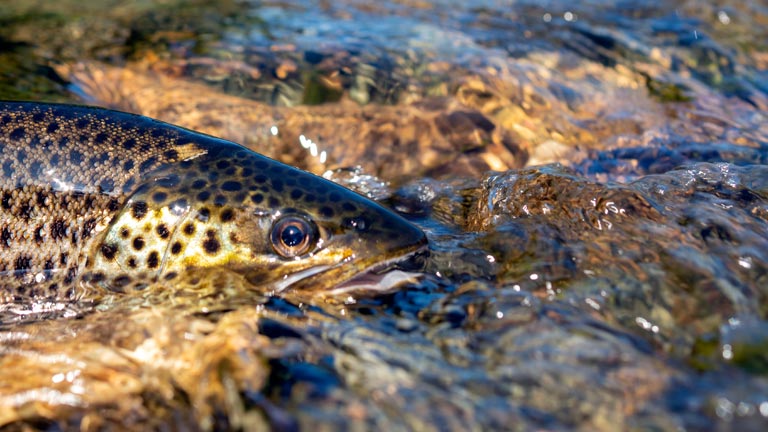Hey, fellow anglers! If you’re as hooked on trout fishing as I am, you know that getting the proper setup is half the battle. Today, I’m spilling the beans on how to set up the ultimate trout fishing line. Before we get into the nitty-gritty, let’s chat about the basics.
Trout are sneaky little critters, so picking how to set up a line for trout fishing is like choosing the perfect brush for a masterpiece. Monofilament and fluorocarbon are the MVPs here because of their low visibility in the water.
Step by Step Guide on How to set up a line for Trout Fishing
Step 1: Choosing Your Fishing Line Sidekick
Monofilament vs. Fluorocarbon
Let’s kick things off by choosing the superhero sidekick for our trout fishing adventure. We’ve got two contenders in the ring – Monofilament and Fluorocarbon. Each has its own set of skills; let’s break it down.
Monofilament: The Jack-of-All-Trades
Monofilament is like the Swiss Army knife of fishing lines. It’s versatile, flexible, and won’t burn a hole in your pocket. The beauty of monofilament lies in its ability to adapt to various fishing situations. Need a line that floats on the water’s surface for those topwater plays? Monofilament is your go-to. Its buoyancy adds a new dimension to your game, making it ideal for specific trout fishing scenarios.
Fluorocarbon: The Stealthy Ninja
If you’re ready to take your trout fishing to ninja level, enter fluorocarbon. This line is invisible underwater, and trout won’t know what hit them. The lack of visibility is a game-changer, especially in clear waters where trout have the eyesight of a superhero. Fluorocarbon also boasts minimal stretch, giving you unparalleled sensitivity. Feel every nibble, twitch, and subtle movement – it’s like having trout radar at your fingertips.
Choosing the Right Sidekick for Your Mission
Deciding between monofilament and fluorocarbon boils down to your fishing style and the conditions you’ll be facing. If you’re starting or enjoy the flexibility of various fishing techniques, monofilament is a solid choice. On the other hand, if you’re aiming for a stealthy approach and want to finesse those tricky trout, fluorocarbon is your secret weapon.
Step 2: Picking the Perfect Pound Test
Trout are the ninjas of clear waters, so we want to be as subtle as possible. Aim for a lower pound test (between 2-6 lbs) to finesse those trout. Lighter lines mean less spooking and more catching.
Step 3: Reel Talk
Now, let’s set up that reel of yours. Here’s the backstage pass:
Backing Up: Attach some backing to your reel for that extra security and to avoid any slippage mishaps.
Main Line Magic: Tie your main fishing line to the backing using an arbor knot. Make it snug – we don’t want any loose ends.
Guiding the Way: Thread the line through those rod guides, starting from the closest to the reel. It’s like connecting the dots but with fishing gear.
Leader of the Pack: Slap on a fluorocarbon leader to the main line for that added invisibility. A blood knot or a double uni knot will be your best friends here.
Step 4: Terminal Tackle Tango
This is where the real action happens. Your terminal tackle is the rockstar of the show:
Swivel Swagger: Attach a quality swivel to prevent line twists and make changing lures a breeze.
Hook, Line, and Sinker: Choose the perfect hook size based on your bait or lure. Treble hooks are the go-to for artificial lures.
Lure Lockdown: Whether it’s live bait or artificial goodies, ensure it’s securely fastened to your hook.
Step 5: Fine-Tuning for Trout Triumph
My fellow angler lovers, we’ve got our stage set, actors in place, and the audience (trout, in this case) eagerly waiting. Let’s talk about the symphony of settings to ensure your trout fishing performance is nothing short of a masterpiece.
Adjusting the Drag System:
Know Your Reel: Each reel is like a unique instrument, and understanding its nuances is key. Locate the drag adjustment on your reel – it’s usually a star-shaped dial or a knob.
Light vs. Heavy Settings: Imagine you’re tailoring a suit; the drag system is your thread tension. For smaller trout, opt for a lighter setting. This allows them to nibble without feeling like they stumbled into a heavyweight boxing match. Conversely, if you’re targeting the larger, more spirited trout, tighten that drag. This prevents them from making a quick getaway with your favorite lure.
Test the Waters (Literally): Before you cast your line into the trout’s domain, give your drag a little test run. Pull the line gently to feel the resistance. It should offer enough pull to tire out the fish without risking a dramatic exit.
Balancing Act: Finding the sweet spot is like balancing on a tightrope – not too loose or tight. Aim for a setting that allows the trout to make a run without snapping your line, providing the perfect blend of excitement and control.
Fine-Tune as You Go: Fishing conditions can be as unpredictable as a jazz solo. Keep an eye on your drag setting throughout your fishing expedition. If you notice the trout putting up a spirited fight or, conversely, not offering much resistance, adjust on the fly (pun intended).
Final Verdict
Mastering trout fishing requires a meticulous approach to crafting the perfect fishing line. The choice between the versatile monofilament and the stealthy fluorocarbon sets the stage for success, aligning with your fishing style and the conditions you’ll face.
Opting for a lower pound test ensures a subtle presence in clear waters. At the same time, the reel setup, terminal tackle finesse, and adjusting the drag system serve as the symphony of settings for a triumphant performance. So, armed with this ultimate guide, fellow angler fans, you’re ready to hit the waters and orchestrate your masterpiece in the world of trout fishing. Tight lines!
